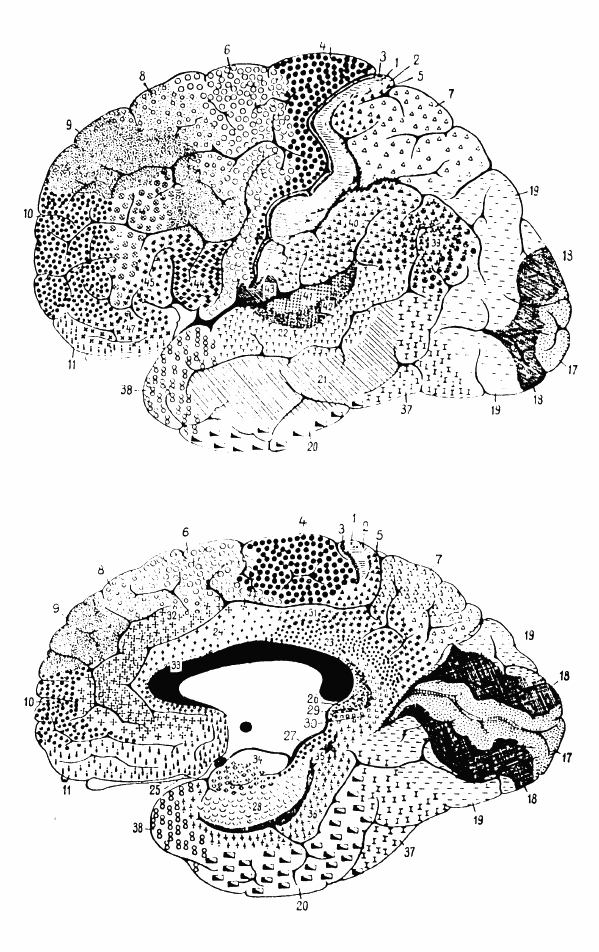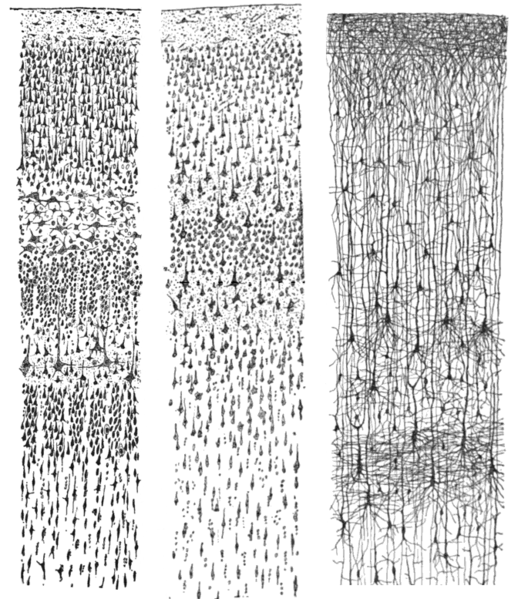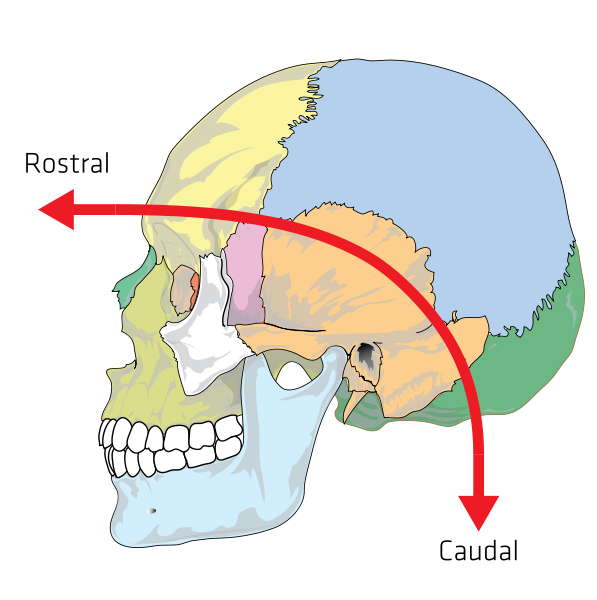Figure 1 –Dr Korbinian Brodmann, German Neurologist, Frontpiece of ‘Localisation in the Cerebral Cortex’, 1909, Public Domain*
The Brain is a complex organ, responsible for the full gamete of our inner experiences whether these are our first thoughts on waking, the perception of a rainbow or the sharing of joy with others. Understanding the brain has been an almost unobtainable goal which many great scientists have striven for. One scientist who realised the immense complexity of the task set out to characterise the brain in a more limited way and in the process established one of the most successful maps of the brain which continues to be routinely used over 100 years later. His name was Dr Korbinian Brodmann. In the first part of this series, there was a brief look at the context of Brodmann’s landmark work ‘Brodmann’s Localisation in the Cerebral Cortex’. In the fifth part of the series we will take a closer look at the 21 pages of his book which relate to the special regions in the human Cerebral Cortex that Brodmann identified.
The central 21 pages of Brodmann’s work are contained within Chapter IV ‘Description of Individual Brain Maps’ in which he contrasts the brain maps of several species including humans. The fourth region he looks at is the Parietal Region in which he identifies ‘four or five areas’. However in the final publication Brodmann assigns only four areas –
1. Brodmann Area 5 which he refers to as the Preparietal Area.
2. Brodmann Area 7 which he refers to as the Superior Parietal Area.
3. Brodmann Area 40 which he refers to as the Supramarginal Area.
4. Brodmann Area 39 which he refers to as the Angular Area.
Figure 2 – Cytoarchitectonics of human brain according to Brodmann (1909), Public Domain*, The Top Diagram is the Lateral Surface of the Cortex, The Bottom Diagram is the Medial Surface
Brodmann suggests that the Parietal Region approximates the Parietal Lobe. However he qualifies this by noting that it also includes part of the paracentral lobule. Furthermore on moving inferiorly there is no clear demarcation both from the Temporal and Occipital Lobes. The other boundaries are the Postcentral Sulcus (demarcating it from the Postcentral Region) as well as the Parieto-Occipital and Subparietal Sulci.
Figure 3 – Three drawings by Santiago Ramon y Cajal, taken from the book “Comparative study of the sensory areas of the human cortex”, pages 314, 361, and 363, Public Domain*
Left: Nissl-stained visual cortex Middle: Nissl-stained motor cortex Right: Golgi-stained cortex
Turning to the Preparietal Area BA5, Brodmann finds this area to be characterised by the presence of very large Pyramidal cells which distinguish it from surrounding areas. Brodmann describes this area as constant in position (corresponding to the Anterior part of the Anterior Arcuate Parietal Gyrus) and sack-like in shape as well as having thickened cortical thickness relative to the Postcentral Cortex. He suggests that it has important biological significance as it is found in a number of other Mammals.
Figure 4 – Simple View of Skull Illustrating Rostral-Caudal Orientation, Created by LadyofHats, Modified by Spiral5800, Public Domain
Brodmann describes this area in terms of the Rostral-Caudal orientation (see Figure 4). Thus on the medial surface of the Cortex the area begins caudally in the Paracentral Lobule and rostrally descends whilst narrowing into the Cingulate Sulcus (see Figure 5) (referred to by Brodmann as the Callosomarginal Sulcus). Moving onto the lateral surface of the Cortex, BA5 widens posterior to the Superior Postcentral Sulcus and widens further in an area demarcated by branches of the same sulcus.
Figure 5 – Cingulate Sulcus, Finn Årup Nielsen, GNU Free Documentation License
Regarding the Superior Parietal Area (Brodmann Area 7), Brodmann writes that on the medial side it is the Superior Parietal Lobule excluding the Precuneus and Preparietal Area. Brodmann clearly identifies the boundaries: Medial – Superior Parietal Lobule; Lateral – Intraparietal Sulcus; Posterior – Parieto-Occipital Sulcus; Anterior – Superior Postcentral Sulcus. Brodmann informally distinguishes anterior and posterior divisions noting that Elliot Smith made a similar observation.
Turning to the Supramarginal Area (Brodmann Area 40), Brodmann writes that this corresponds to the Supramarginal Gyrus. There is no obvious demarcation from Brodmann Area 22 while it is separated from Brodmann Areas 2 and 43 by the Inferior Postcentral and Posterior Subcentral Sulci.
Finally regarding the Angular Area (Brodmann Area 39), Brodmann writes that this approximates the Angular Gyrus. While the Intraparietal Sulcus separates it from the Parietal Area (presumably Area 7 although it wasn’t clear) there are no clear boundaries with Brodmann Areas 19 and 37.
References
Brodmann’s Localisation in the Cerebral Cortex. 1909. Translated and Edited by Laurence J Garey. Springer. 2006.
*Public Domain in those countries where the Copyright term of the life of the author (Korbinian Brodmann 1868-1918) plus the additional country specific term has lapsed from Copyright at the time of writing
An index of the TAWOP site can be found here and here. The page contains links to all of the articles in the blog in chronological order. Twitter: You can follow ‘The Amazing World of Psychiatry’ Twitter by clicking on this link. Podcast: You can listen to this post on Odiogo by clicking on this link (there may be a small delay between publishing of the blog article and the availability of the podcast). It is available for a limited period. TAWOP Channel: You can follow the TAWOP Channel on YouTube by clicking on this link. Responses: If you have any comments, you can leave them below or alternatively e-mail justinmarley17@yahoo.co.uk. Disclaimer: The comments made here represent the opinions of the author and do not represent the profession or any body/organisation. The comments made here are not meant as a source of medical advice and those seeking medical advice are advised to consult with their own doctor. The author is not responsible for the contents of any external sites that are linked to in this blog.





[…] The Most Important 21 Pages In The Field of Neuroscience? Dr Korbinian Brodmann. The Man Who Mapped … […]
LikeLike
[…] The Most Important 21 Pages In The Field of Neuroscience? Dr Korbinian Brodmann. The Man Who Mapped … […]
LikeLike
[…] The Most Important 21 Pages In The Field of Neuroscience? Dr Korbinian Brodmann. The Man Who Mapped … […]
LikeLike
[…] The Most Important 21 Pages In The Field of Neuroscience? Dr Korbinian Brodmann. The Man Who Mapped … […]
LikeLike
[…] The Most Important 21 Pages In The Field of Neuroscience? Dr Korbinian Brodmann. The Man Who Mapped … […]
LikeLike
[…] The Most Important 21 Pages in the Field of Neuroscience: Dr. Korbinian Brodmann – Part 5 […]
LikeLike